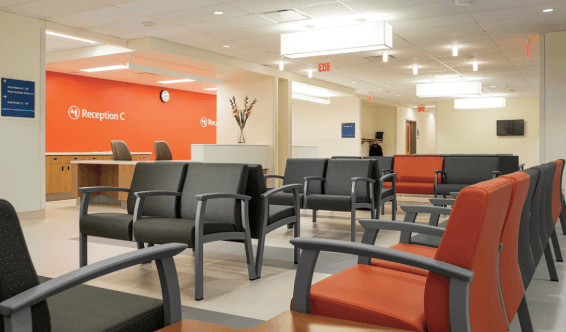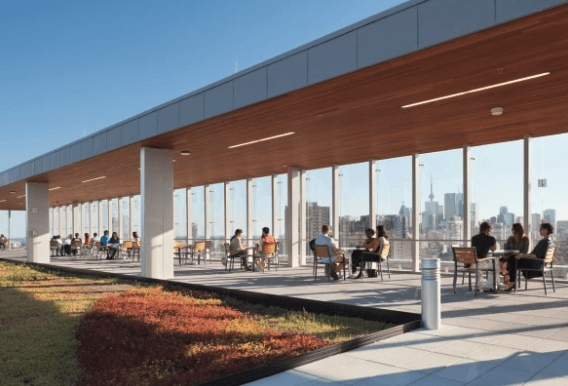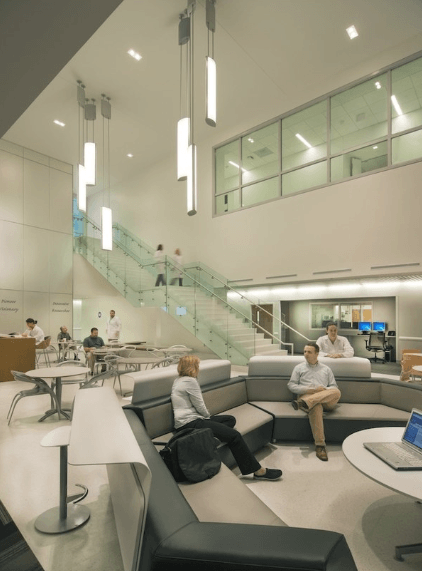
For the past few years, many corporations have been rethinking office spaces in an effort to inspire creativity and innovation in employees. Hospitals are joining the movement and searching for a cure for the drab, sterile interior designs that have been the norm for decades. In fact, forward-thinking hospitals are realizing that good design that improves patients’ moods can actually help people get well faster. Here are two elements of creative design that impact both healthcare professionals and the patients they serve.
Strategic Color
Just as the strategic use of color gained traction as a powerful design element in office settings, healthcare design is also embracing color to influence productivity, creativity, and mood.
St. Joseph’s Hospital is a leader in healthcare research and patient care that worked with Global Furniture Group for their redesign. The Canadian-based hospital uses a distinct color scheme of oranges throughout one of its waiting rooms to create a unique area that symbolizes warmth, encouragement, and life in what can be a sterile, cold space.

Do these carefully colored spaces really impact the patients using them? Color expert Angela Wright explains, “When the study of color harmony is combined with the science of psychology, reactions can be predicted with startling accuracy.” This means designers working in the health care sector can strategically use color in patient rooms and waiting areas to bring a sense of comfort that promotes resilience and empathy.
Dynamic Spaces
Inspired by research that shows the physical environment can help patients feel less stressed, take less pain medicine, and improve more quickly, innovative designers have created spaces that put patient comfort first. Bridgepoint Active Healthcare is an example of an innovative design that focuses on patient wellbeing. Every patient room in this Toronto chronic disease center has panoramic views of trees and parks and patients can relax on open terraces.

Large, open glass staircases and a courtyard with a labyrinth outside invite people (both patients and staff) to walk and get a little extra exercise. Innovative hospital architecture and design not only benefit patients, but they also encourage administrators, researchers, and health care professionals to connect, create, and innovate.
The Gates Vascular Institute in Buffalo N.Y. is a vascular hospital on the bottom floors, a University research and lab space on the top floors, and in the middle, an innovation hub to connect researchers and practicing physicians from different specializations.

In contrast to traditional hospital design where researchers, physicians, and patients are separated by geography, The Gates Vascular Institute is designed to encourage interaction:
● Collision zones: little meeting spaces outside of labs and operating rooms encourage doctors and researchers to hold impromptu meetings and brainstorm sessions
● Atrium: a two-story gathering place in the center of the building
● Windows: Labs and conference rooms look out over community spaces
● Open staircase: connects the floors, creating an open, fluid atmosphere
These architectural and design choices foster chance encounters and intersections, which are key elements of experimentation and innovation. By breaking down physical barriers, institutional ones are also removed.
Healthcare providers and builders are realizing that they must go beyond provide functional spaces to those that have the power to inspire, energize and also relax. It’s not just patients who benefit, but anyone who walks through the door.
Related: How Design Thinking in Healthcare Can Improve the Patient Experience
Image credits
– https://www.wired.com/2013/10/this-hospital-was-designed-to-be-an-innovation-hub/
– https://www.fastcompany.com/3048984/5-gorgeous-hospitals-that-show-how-good-design-can-improve-patients-lives
– https://www.globalfurnituregroup.com/healthcare/resources/projects#project-80

